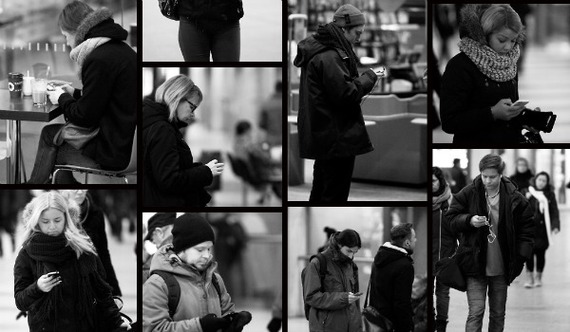Remember when people looked at each other?
I know, it's been a while. But try.
I stepped off the train the other day, and as I looked ahead at the masses waiting to get on, I was struck by a sea of downward gazes. No one was looking forward; no one was making eye contact. Rather, everyone was staring at their hands or, more specifically, the small screens in their hands.
Studies show that we're making eye contact less frequently and for shorter periods of time than ever before (and since we check our phones upwards of 150 times per day, when would we have time for eye contact?). There's even an entire Tumblr dedicated to visually documenting our seeming inability to look up. We read and talk a lot about the effects of technology on communication and relationships. But what about the simple act of seeing? Of watching and being witnessed? What happens when we stop looking at each other?
Logical reasoning might suggest that the relevance of appearances would therefore fade. But appearances matter now more than ever: Our image is no longer limited to our physical presence, and its virtual replication has unprecedented reach and permanence.
And yet, we look at each other in bodily form less than ever. Maybe some will have cause for celebration if this leads to a decline in catcalls, but in contexts where the attention is welcome -- or even necessary -- this will continue to radically transform the mating ritual.
So what aren't we seeing? It's difficult to describe the reality of what we so often look away from without sounding cliche. On a single day I looked up from my screen to see a devastatingly down-and-out man positioning his sign in search of food; a vast expanse of water and trees whizzing by outside the train window; a bright pink raincoat that punctuated the sea of otherwise neutral colored bodies, scurrying to their offices. Suffering, beauty, anomalous choices -- these are the subtleties of everyday life that we've expertly eliminated from our vision.
We often prefer to stay glued to a steady stream of curated content and digital correspondence directed specifically at us, especially when we're alone. But there is value in casting our gaze upon the general backdrop of everyday life. It's the visual equivalent of chatter: The peripheral incidentals that cross our paths, not specifically intended for us, but not without consequence to our lives -- if we let them in.
I love getting lost in my personal smartphone universe as much as the next person. But whenever I do come up for some ocular air, I find I breathe a little easier, my pulse slows a bit and serendipitous encounters unfold exponentially. Screens are our social safety net, but they also shield us from the richness of what our eyes might otherwise stumble upon.
Sociological Challenge: Don't pull out your smartphone or tablet for your entire commute or while eating lunch alone or while you wait for a friend in a bar. (No cheating.) Try to make eye contact with at least three people. What do you see that may have otherwise escaped you if you'd been buried in a screen?
[Image credit: We Never Look Up]

